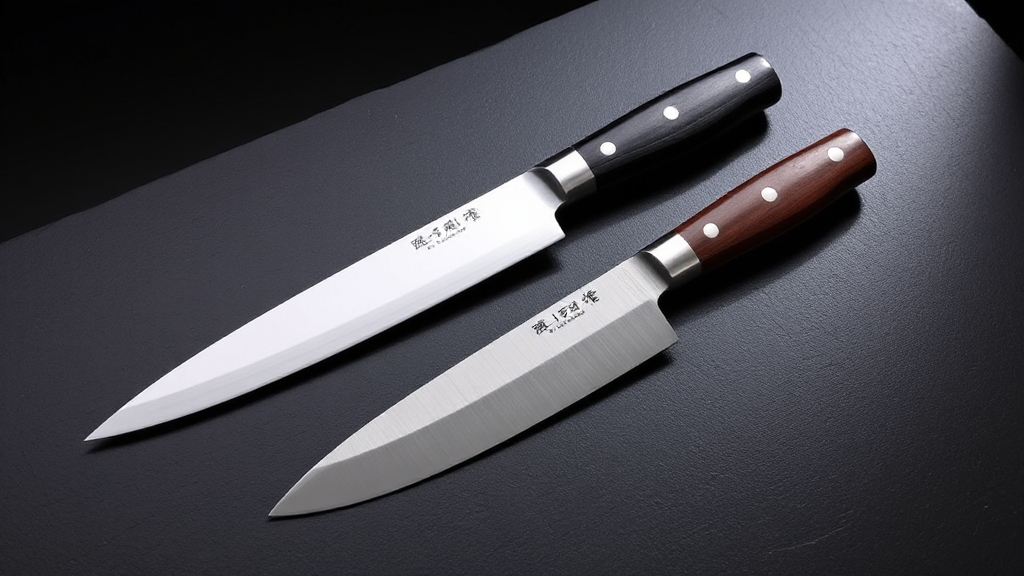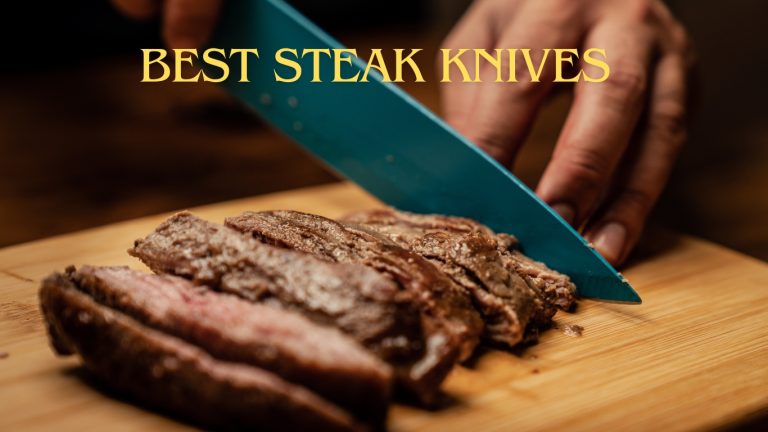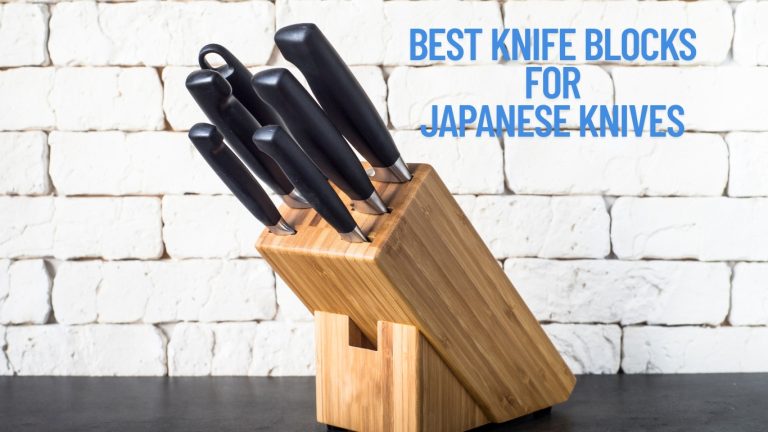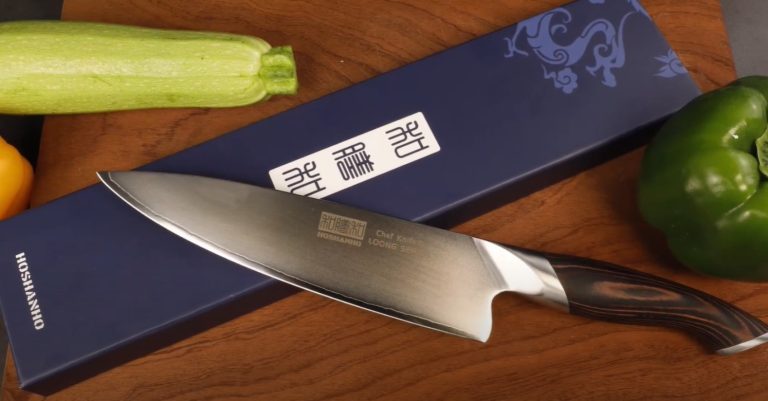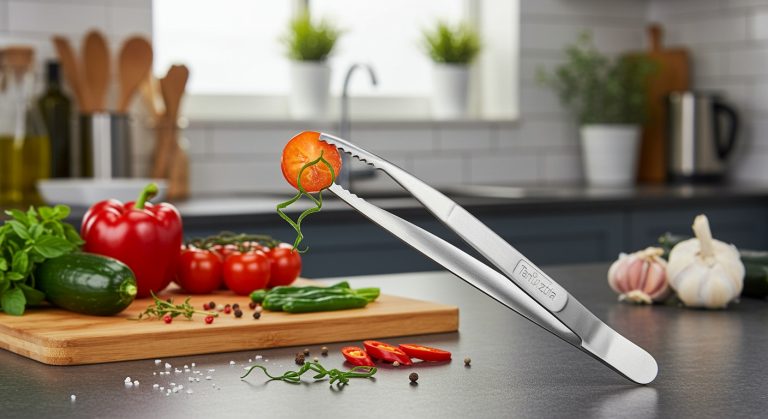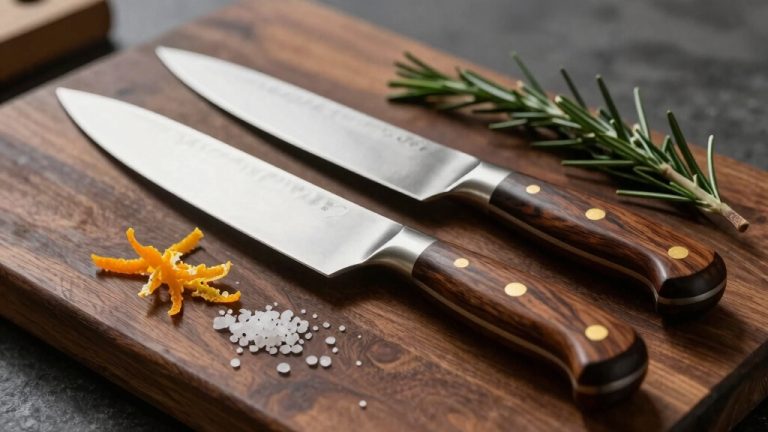Kiritsuke vs Gyuto: Which Knife Belongs in Your Kitchen?
When choosing between a Kiritsuke and a Gyuto, you’re picking between precision and versatility in the kitchen.
The Kiritsuke, with its single-bevel edge and angled tip, offers unmatched sharpness for delicate sushi cuts and intricate tasks. Meanwhile, the double-bevel Gyuto shines as an all-purpose chef’s knife, perfect for chopping and mincing with ease.
Your cooking style dictates the winner—whether you prioritize finesse or flexibility. Stick around to uncover deeper insights!
Key Takeaways
- Kiritsuke has a single-bevel edge for precision, while Gyuto’s double-bevel offers versatility.
- Kiritsuke excels in push-cutting delicate foods; Gyuto suits varied techniques.
- Gyuto is beginner-friendly with easier handling; Kiritsuke requires more skill.
- Kiritsuke is ideal for sushi and thin slices; Gyuto handles denser cuts.
- Choose Kiritsuke for intricate tasks, Gyuto for all-purpose kitchen use.
Blade Design Differences
Immerse yourself in the world of Japanese knives, and you’ll quickly notice the striking blade design differences between a kiritsuke and a gyuto. The kiritsuke boasts a long, slender shape with a straight edge and an angled tip, crafted for precision.
In contrast, the gyuto features a curved edge and rounded profile, making it a versatile companion in the kitchen. This design allows the gyuto to handle a wide variety of tasks effortlessly, catering to diverse culinary needs.
Dive deeper, and you’ll see the kiritsuke’s single-bevel design offers unmatched sharpness, though it demands skill to wield.
The gyuto’s double-bevel edge, however, provides balance and ease, perfect for beginners. Additionally, the gyuto’s longer blade, often ranging from 180 to 300mm, excels in slicing through larger items with precision.
Notice the kiritsuke’s sleek, straight-edge aesthetic against the gyuto’s traditional curved look.
Cutting Technique Applications
As you explore the practical applications of Japanese knives, you’ll find that the kiritsuke and gyuto shine in distinct cutting techniques tailored to their designs.
With a gyuto, you’ll excel in rock-chopping, effortlessly processing herbs and vegetables thanks to its curved blade. It’s versatile, adapting to various tasks, making it ideal for beginners and pros alike.
Additionally, the gyuto’s design offers a slight curve that enhances its effectiveness in multiple cutting techniques. The gyuto’s lighter weight and sharper edge also allow for delicate precision cuts, perfect for intricate vegetable work.
The gyuto’s curved blade masters rock-chopping, making herb and vegetable prep a breeze. Its versatility suits both novice and expert chefs perfectly.
On the other hand, the kiritsuke’s flat profile masters push and pull chopping, offering smooth board contact. You’ll appreciate its precision, especially with the unique tip, perfect for intricate cuts in tight spaces.
Single and Double Bevel Variations
As you explore the world of Kiritsuke and Gyuto knives, you’ll notice how single bevel designs offer unmatched precision, letting you slice through sushi or vegetables with clean, effortless cuts thanks to their one-sided grind.
On the flip side, you can’t overlook the double bevel’s versatility, as its symmetrical edge makes chopping and mincing a breeze for any skill level with easier sharpening at standard angles.
Additionally, double bevel knives often provide greater cutting durability due to their robust design, making them less prone to chipping on tougher ingredients.
Let’s unpack how these distinct benefits shape your choice between tradition and adaptability in the kitchen. Whether you’re a seasoned chef or a home cook, understanding that double bevel knives are often more ambidextrous in use can help you decide if they suit your dominant hand and cutting style.
Single Bevel Benefits
Immerse yourself in the world of single bevel knives, and you’ll quickly discover why they’re a game-changer for precision cutting.
With a thinner, sharper edge honed at 15-17°, you’ll slice through delicate foods like sashimi with unmatched cleanliness, enhancing presentation and flavor. The angled edge minimizes food sticking, guiding slices away effortlessly, while the chisel-like geometry guarantees wafer-thin cuts of daikon or fish with minimal effort.
You’ll excel in traditional Japanese tasks, from peeling vegetables to precise sushi preparation, preserving texture and aesthetics. Single bevel knives are particularly ideal for specialized tasks like filleting fish, where precision is paramount.
Sharpening’s a breeze with single-side control, offering faster maintenance and superior edge retention on tender ingredients. Though they demand skill and care, these hand-forged blades, crafted from harder steels, redefine precision in your kitchen.
Double Bevel Advantages
While single bevel knives shine in precision tasks, double bevel knives bring a whole new level of versatility to your kitchen arsenal.
You’ll find that both Kiritsuke and Gyuto knives with double bevel edges excel in handling meats, veggies, and more, thanks to their balanced design. They’re ambidextrous, so whether you’re left or right-handed, you’ll wield them with ease.
Beyond versatility, you’ll appreciate how simple they’re to sharpen compared to single bevels, saving you time and effort. Additionally, the double bevel design allows for a more even distribution of wear on the edge, extending the knife’s lifespan even wear distribution.
Their robust build guarantees durability for heavy use, and the 20-30 degree edge angle offers flexibility for chopping and slicing.
Moreover, the ergonomic handle design of these knives ensures a comfortable grip during extended use, reducing hand fatigue ergonomic handle design.
Material and Build Quality
When you immerse yourself in the world of Kiritsuke and Gyuto knives, the material and build quality stand out as key factors that shape their performance.
Exploring Kiritsuke and Gyuto knives reveals how material and build quality critically influence their exceptional performance.
You’ll notice Gyuto knives often use stainless steel for rust resistance or carbon steel for razor-sharp edges, though they need extra care. Kiritsuke knives match this with similar materials, prioritizing sharpness and durability, sometimes featuring stunning Damascus patterns for added strength and beauty.
Dive deeper, and you’ll appreciate Gyuto’s full-tang construction, ensuring balance with a full or semi-bolster. Carbon steel options in both knives offer exceptional edge retention due to their finer grain structure, making them ideal for precision tasks.
Kiritsuke’s slender design might shift handling, yet both boast ergonomic handles—often wood or synthetic—for lasting comfort. Both knives also benefit from high-quality Japanese craftsmanship, ensuring a solid steel core for long-lasting durability.
Versatility in Kitchen Tasks
When you’re sizing up the versatility of kitchen knives, you’ll notice the Gyuto’s broad utility makes it a true workhorse, effortlessly tackling everything from meat slicing to vegetable chopping with its adaptable curved edge.
On the flip side, you can’t overlook the Kiritsuke’s knack for precise cuts, shining in delicate tasks like sashimi slicing thanks to its straighter, focused profile.
Let’s explore how these strengths shape your cooking experience across various kitchen challenges. The Gyuto’s design also allows for efficient rocking motion cuts, making it particularly adept at dicing herbs and vegetables with ease.
While both knives excel in their own domains, the Gyuto stands out for its beginner-friendly design, making it an ideal choice for those new to Japanese knives beginner-friendly design.
Gyuto’s Broad Utility
As you step into the kitchen, you’ll quickly find that the Gyuto knife stands out as a true all-rounder, ready to tackle nearly any task with finesse.
Whether you’re slicing tender meat, filleting fish with clean cuts, or dicing vibrant vegetables, this blade adapts effortlessly. Its thin design and balanced weight let you push-cut firm ingredients, pull-cut softer ones, and even tap-chop herbs to preserve their aroma.
With lengths from 7 to 10 inches, you’ve got options for every job, from mincing garlic to disjointing joints.
The Gyuto’s versatility means you won’t need a cluttered drawer of specialized tools. It’s a space-saver, easy to maintain, and a favorite for both home cooks and pros worldwide.
Originating in Japan’s Meiji period, the Gyuto was initially designed for beef but now excels in multiple kitchen tasks Meiji period origin.
Kiritsuke’s Precise Cuts
Precision becomes your ally with the Kiritsuke knife, a blade crafted for meticulous cuts that elevate your kitchen game.
With its single-bevel edge, you’ll achieve ultra-sharp slices, perfect for delicate sashimi or translucent cucumber cuts. The angled tip lets you master intricate tasks like scoring fish skin or julienning vegetables with micro-precision.
Feel the long, flat profile glide through proteins, minimizing drag, while the concave backside prevents sticking for cleaner separation. Its design also allows for precise boning tasks, making it ideal for separating meat from bone with minimal effort.
Whether you’re push-cutting leafy greens to avoid bruising or pull-cutting sushi for mirror-finish slices, you’ve got control. The hybrid design shines as you trim meat or debone fish effortlessly.
With a balanced grip and blade-forward weight, you’ll slice through high-volume prep with ease and finesse. This knife’s versatility makes it a standout choice for both professional chefs and home cooks seeking precision and control.
Precision and Specialty Uses
Immerse yourself in the world of the kiritsuke, and you’ll quickly see why it’s a master of precision and specialty tasks in the kitchen.
With its angled tip and single-bevel edge, you’ve got unparalleled control for intricate cuts like sashimi portioning or decorative vegetable carving.
That flat blade profile guarantees even, clean slices through fish and boneless meats with a push-cutting motion, while the reverse tanto tip shines in detailed garnish work.
Experience unmatched precision with the kiritsuke’s angled tip and single-bevel edge, perfect for intricate sashimi cuts and detailed vegetable carving.
For specialty uses, you can craft paper-thin katsuramuki vegetable slices or transparent usuzukuri fish cuts without tearing.
Mastering this blade demands skill—align your edge, control pressure, and maintain consistent motion to avoid snags. Its long, slender shape offers versatility and precision for a variety of detailed tasks.
Market Options and Availability
When you’re diving into the market for kiritsuke and gyuto knives, you’ll find a vibrant landscape filled with options to suit every need and budget.
Brands like Shun, Masamoto, and Sakai Takayuki offer exceptional quality, available through online platforms such as Knife Merchant and Korin, or at local specialty stores for a hands-on feel.
Prices range from $89.95 to $761, with diverse materials like Damascus steel. You’ll also find exclusive products and high-end options from brands like Yaxell and Miyabi, catering to both professional chefs and home cooks seeking premium blades.
Check out these exciting market perks:
- Top Brands: Shun and Yoshihiro deliver sharpness and durability.
- Online Ease: Sites like Japanese Knife Imports provide handcrafted gems.
- Local Touch: Specialty stores let you test before buying.
- Custom Finds: Unique finishes and limited editions await enthusiasts.
Choosing Based on Cooking Style
As you explore the world of Japanese knives, you’ll find that choosing between a kiritsuke and a gyuto often hinges on your unique cooking style.
If you’re into precise push-cutting or delicate vegetable work, the kiritsuke’s flat profile and angled tip offer unmatched control for julienne cuts and intricate tasks.
However, if you lean toward versatile, all-purpose prep or rock-chopping herbs and garlic, the gyuto’s curved belly adapts effortlessly to varied motions and mixed ingredients.
For meat-heavy tasks, grab a gyuto—its thicker spine tackles dense cuts and bone proximity with ease.
Yet, for sashimi-style slicing or fragile produce like mushrooms, the kiritsuke’s acute precision shines.
Keep in mind that the kiritsuke can feel awkward for general prep tasks due to its specialized design specialized design.
Frequently Asked Questions
Which Knife Is Better for Beginners?
Hey, if you’re just starting out in the kitchen, picking the right knife can make all the difference.
Go for a blade that’s forgiving and easy to handle. You’ll want something versatile for chopping veggies, slicing meat, and mincing herbs without a steep learning curve.
Opt for a knife with a symmetrical edge and comfortable weight. It’ll boost your confidence and skills as you practice cutting techniques daily.
How Do Maintenance Needs Differ?
Hey, when it comes to knife maintenance, you’ve gotta know the differences to keep your blade in top shape.
You’ll need to sharpen more often if the edge wears quickly, sometimes monthly with heavy use.
Don’t skip weekly honing to maintain precision.
Pay attention to balance during sharpening to avoid uneven wear.
And always dry immediately after use, applying oil if rust’s a risk, to protect your investment.
Are There Cultural Significances to Each?
Immerse yourself in a world where knives are more than tools; they’re cultural treasures.
You’ll find that blades carry deep significance, embodying heritage and skill in every slice. Explore how they symbolize authority and tradition, reflecting a chef’s mastery in their craft.
Notice the prestige tied to certain designs, reserved for the elite. You’re not just cutting; you’re honoring history.
Feel the weight of culture in every precise motion.
Which Knife Suits Smaller Hands?
Hey, if you’ve got smaller hands, finding the right knife is key to comfort and control.
Look for a lighter blade that doesn’t overwhelm your grip, and consider shorter lengths for better maneuverability.
Ergonomic handles are a must to reduce strain during long prep sessions.
You’ll want a knife that adapts to your cutting style, ensuring precision without feeling cumbersome.
Trust me, the right fit transforms your kitchen game!
How Do Sharpening Techniques Vary?
Hey, you think sharpening a knife is just scraping it on a stone? Think again!
Immerse yourself in the art of sharpening techniques, and you’ll find a world of precision. You’ve gotta master the angle—usually 15 degrees per side—and glide that blade across a wet whetstone with finesse.
Switch grits from coarse to fine, and don’t skip honing. It’s your ticket to a razor-sharp edge every time!
Sharpen Your Skills—Start with the Right Blade
Hey, you’ve got a tough choice between a kiritsuke and a gyuto, but it’s all about your cooking vibe! Did you know over 60% of home chefs prefer the gyuto for its versatility?
If you’re slicing everything from veggies to meats daily, go gyuto. But if precision in intricate cuts calls your name, pick the kiritsuke.
Match your blade to your style, and you’ll master your kitchen game effortlessly!

